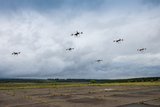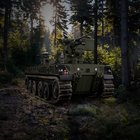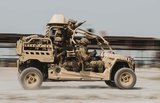Rockwell Collins awarded new damage tolarance contract from DARPA
Rockwell Collins has been awarded the third phase of a damage tolerance contract by the Defense Advanced Research Projects Agency (DARPA).
Under the contract, Rockwell Collins will demonstrate completely autonomous takeoff, recovery from extreme damage and failure, and autonomous landing of an unmanned subscale F/A-18. Additional flight tests will be conducted on an operational Unmanned Aircraft System (UAS).
Over the course of approximately 15 months, Rockwell Collins will demonstrate its full Damage Tolerance and advanced controls capabilities.
Flight tests will demonstrate increasing damage to both the subscale F/A-18 and an operational UAS, including the failure of control surfaces and parts of the wing, as well as loss of vertical and horizontal tail surfaces. The flight tests will also include an “engine-out” condition followed by automatic adaptive recovery and emergency autoland.
“In addition to demonstrating increased reliability of unmanned aircraft, the damage tolerance work we are doing with DARPA goes a long way in facilitating evolving applications for UAS and the safe coexistence of manned and unmanned aircraft in common airspace,” said Dr. David Vos, Senior Director of Control Technologies for Rockwell Collins. “Unmanned aircraft reliability in the battlespace will ensure that U.S. and Allied forces receive real-time high quality Intelligence, Surveillance and Reconnaissance (ISR) data.”
“This next phase of the Damage Tolerance program will demonstrate that technology exists to reliably control UAS operating under the most challenging conditions such as extreme damage, upset or failure,” said DARPA Program Manager James McCormick.
Damage Tolerance Phase III follows Phases I and II, which were completed in April 2008. In Phase II, the technology demonstrated an aircraft could survive catastrophic wing damage, recover its baseline performance, and safely land – all autonomously.
More from Uncrewed Vehicles
-
![Ready for the race: Air separation drone swarms vs. air defence systems]()
Ready for the race: Air separation drone swarms vs. air defence systems
As the dynamics of aerial combat rapidly evolve, Chinese scientists have engineered a sophisticated air separation drone model that can fragment into up to six drones, each capable of executing distinct battlefield roles and challenging the efficacy of current anti-drone defences such as the UK’s Dragonfire laser system.
-
![Israel’s MALE UAVs ‘must adapt’ to Iranian-made air defences]()
Israel’s MALE UAVs ‘must adapt’ to Iranian-made air defences
Advancements in air defence technologies have begun to reshape aerial combat dynamics in the Middle East, as illustrated by recent events involving the Israeli Air Force and Hezbollah.
-
![Hundreds more UAS sent to Ukraine forces with thousands more on the way]()
Hundreds more UAS sent to Ukraine forces with thousands more on the way
Both sides of the Russia-Ukraine war have been using UAS for effective low-cost attacks, as well as impactful web and social media footage. Thousands more have now been committed to Ukrainian forces.
-
![AI and software companies selected for US Army Robotic Combat Vehicle subsystems]()
AI and software companies selected for US Army Robotic Combat Vehicle subsystems
The US Army has intentions to develop light, medium and heavy variants of the Robotic Combat Vehicle (RCV) as part of the branche’s Next Generation Combat Vehicle family.
-
![DroneShield to improve software of DroneSentry-X C-UAS system under new contract]()
DroneShield to improve software of DroneSentry-X C-UAS system under new contract
DroneSentry-X, a cross-vehicle compatible, automated 360° C-UAS detect and defeat device, can offer 360° awareness and protection using integrated sensors. According to its manufacturer, it is suitable for mobile operations, on-site surveillance and on-the-move missions.
-
![Ukraine takes delivery of new indigenous C-UAS systems]()
Ukraine takes delivery of new indigenous C-UAS systems
Funded by the country’s former president, the new C-UAS systems will be sent to the frontline where they have already been tested against Russian invading forces.


























